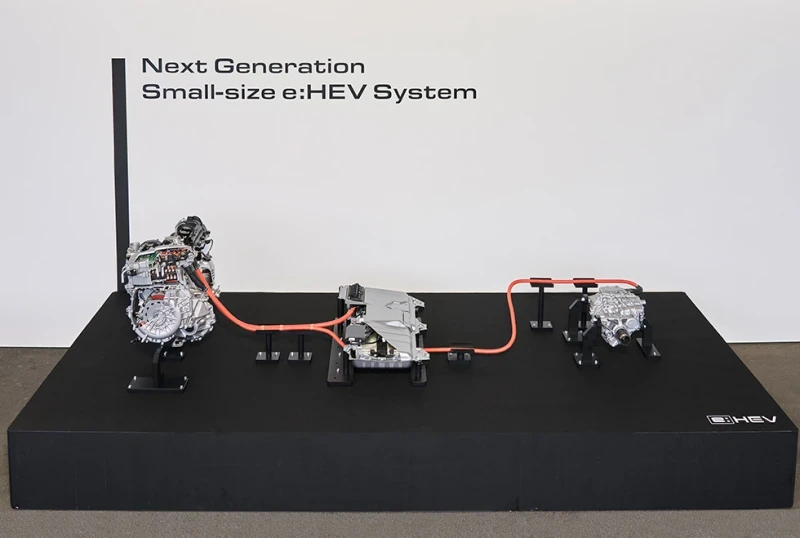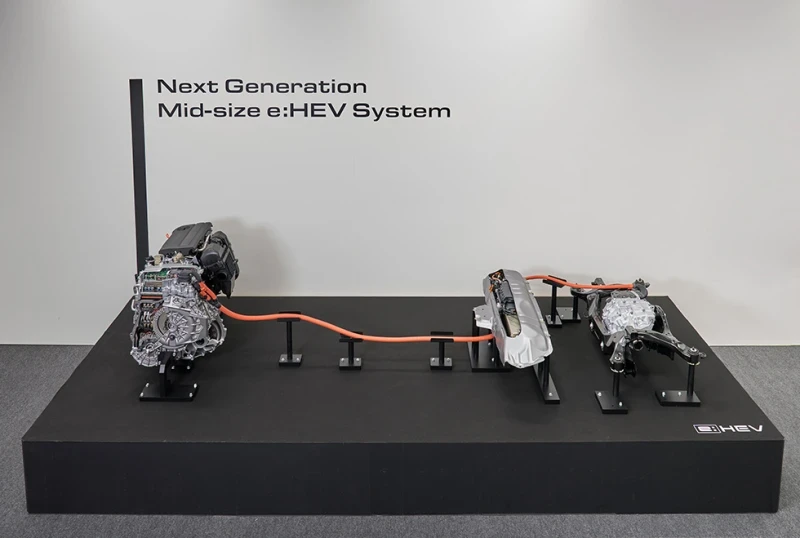In Tokyo, Honda Motor held a press briefing on next-generation technologies for its original 2-motor hybrid system, e:HEV, and presented the world premiere of Honda S+ Shift technology. Honda plans to install Honda S+ Shift in all of its future hybrid-electric vehicle (HEV) models featuring the next-generation e:HEV, starting with the all-new Honda Prelude scheduled to go on sale in 2025. (Earlier post.)
The original Honda e:HEV hybrid system combines fuel economy (environmental performance), achieved by the efficient 2-motor hybrid system, and high-quality and exhilarating driving experience (driving performance), delivered by the high-powered traction motor. By optimally alternating between the motor and the engine as a source of driving force and applying highly efficient controls depending on the driving environment and conditions, e:HEV achieves high fuel economy without making it a conscious effort of the driver and realizes driving at the will of the driver, responding linearly to driver inputs.
The newly developed Honda S+ Shift is a new function designed to pursue the “joy of driving” that further accentuates the sense of oneness between the driver and the vehicle, while fully leveraging the characteristics of the e:HEV system.
The further advancement was made to the Linear Shift Control synchronizing vehicle speed with engine sound, which has been installed in e:HEV models starting with the Fit e:HEV that launched in 2020. Without compromising high environmental performance unique to HEV models, the Honda S+ Shift precisely controls the engine RPM during acceleration and deceleration to realize direct drive response and sharp gear shifting.
Moreover, the engine sound synchronizes with the Active Sound Control (ASC) system, enhancing engine sound quality by offering the engine sound in sync with engine RPM through the speaker system and the highly responsive meter display. Honda explains that in this way, the Honda S+ Shift will stimulate all of the driver’s senses and provide exhilarating driving at the will of the driver, further “synchronizing” the driver and the vehicle.
Key features of Honda S+ Shift:
- The Honda S+ Shift further advances the Linear Shift Control applied to current e:HEV models, enabling gear shifts (upshift and downshift) according to the driving conditions and environments at all speed ranges. While turning, the Honda S+ Shift system quickly responds to driver steering input and activates shift hold, enabling the vehicle to trace the desired driving line at the will of the driver.
- By maintaining the optimal engine RPM for the particular driving conditions, the power generated by the engine during re-acceleration will be fully utilized as driving force. This greatly improves the initial response time of the motor when the driver depresses the accelerator pedal and enables overwhelmingly high response that is directly connected to driver input.
- Although e:HEV does not have a mechanical transmission mechanism, when the Honda S+ Shift is activated, the driver can shift gears with a paddle shifter, so that the driver can enjoy driving feel as if the vehicle features a transmission system. With quick gearshift responses achieved through the coordination of the engine and high-power motor, Honda S+ Shift function will strive to offer the joy of driving based on direct response to driver input.
The letter “S” in the technology name, Honda S+ Shift, has been used in the names of Honda models and technologies such as the S600, S2000, and Type S, representing the “sports spirit,” which Honda believes to be the source of the joy of driving. The “+” indicates that this function will add new value represented by words such as “Synchronized” “Special” and “Sensational.” The word “Shift” represents the Honda desire to make a shift that takes people and automobiles to the new world.
The next-generation e:HEV system. The e:HEV realizes highly efficient driving in all situations by seamlessly and automatically switching between three modes: 1) the EV Drive Mode, where the vehicle runs using only electricity from the battery; 2) the Hybrid Drive Mode, where the vehicle runs on the motor alone using electricity generated by the engine; 3) and the Engine Drive Mode, unique to Honda e:HEV, where the engine is directly connected to the wheels via a clutch.

For the next-generation e:HEV, component parts, including engine and drive unit, and control technology will be renewed respectively for both the small-size system (with a 1.5-liter engine) and the mid-size system (with a 2.0-liter engine) to further improve environmental performance and a high-quality and exhilarating driving experience of e:HEV models.
- The all-new 1.5-liter and 2.0-liter direct-injection Atkinson cycle engines, front drive unit and integrated cooling system will be developed, and by combining them with the new Next-generation Mid-size Platform currently being developed, Honda will aim to improve fuel economy of the next-generation e:HEV models with the mid-size system by more than 10% compared to the first-generation 2-motor hybrid models.
- In light of compliance with future environmental regulations around the world, the new engines are designed to realize a theoretical air-fuel ratio*3 without compromising power output for all driving situations, from everyday driving and situations where powerful acceleration is required such as merging onto an expressway, realizing both excellent power output and fuel economy.
- The new 1.5-liter engine will achieve a significant improvement in fuel economy by expanding the range where engine RPM becomes highly efficient in balance with engine torque, by more than 40% compared to the current 1.5-liter engine for the e:HEV system.
- The new front drive unit will feature both downsized packaging and increased efficiency. By maximizing the commonality between the drive unit for the small-size and mid-size systems, the cost will be reduced significantly, which contributes to the improvement of business viability.
- Moreover, engine and motor performance in each drive mode will be made even more efficient. In Engine Drive Mode, the fuel economy will be improved by increasing torque transmission efficiency when the engine is directly connected and also by expanding range where highly-efficient Engine Drive Mode will be used during high-speed cruising by utilizing battery assist.
- The power conversion and engine efficiency will also be improved for EV Drive Mode and Hybrid Drive Mode. As a result, both 1.5-liter and 2.0-liter engines will achieve the highest combustion efficiency.
Electric all-wheel drive unit. Starting with the next-generation e:HEV models, Honda will adopt an electric AWD drive unit (E-AWD) that can be shared between hybrid-electric vehicles and EVs. Compared to the mechanical AWD, the E-AWD increases maximum driving force and contributes to the realization of more powerful starting acceleration performance.
The technology to control distribution of driving force to the front and rear tires, which Honda has amassed through the development of mechanical AWD, will be further advanced to enable the E-AWD system to optimize front-rear driving force distribution based on changes in tire ground contact load during acceleration/deceleration and turning.
Moreover, by precisely controlling the highly precise and responsive motor torque control, the vehicle’s ability to trace the desired driving line and driving stability will be improved regardless of road surface conditions, enabling driving at the will of the driver and with greater peace of mind.

Next-generation Mid-size Platform. In line with the advancement of the next-generation e:HEV system, Honda will completely renew current mid-size platform for its hybrid-electric vehicles and pursue the further wholistic advancement of the vehicle.
New body rigidity management was adopted to realize high driving stability and lightweight. A sporty and exhilarating driving experience will be achieved by adopting a new steering stability index, which provides the ability to flex the vehicle body to control load on each tire during cornering. The simplified body structure also contributes to an overall vehicle weight reduction by 10% compared to current Honda e:HEV models.
Moreover, Honda is striving to develop the lightest platform in its class by reducing the platform weight by approximately 90kg compared to the platform for the current e:HEV models through the adoption of a new design method and a new lightweight body.
Based on the modular architecture concept, which realizes a high commonality ratio among various models, series models will be developed while common sections, such as the engine room and rear floor, and unique sections such as the rear cabin are developed separately. With this development method, Honda is striving to achieve a commonality ratio of more than 60% among all models that adopt this Next-generation Mid-size Platform. This will enable production of unique and diverse models more efficiently and cost-effectively.
Source from Green Car Congress
Disclaimer: The information set forth above is provided by greencarcongress.com independently of Alibaba.com. Alibaba.com makes no representation and warranties as to the quality and reliability of the seller and products. Alibaba.com expressly disclaims any liability for breaches pertaining to the copyright of content.




